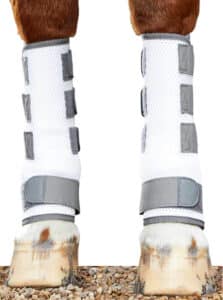Summer brings with it an array of irritating insects, but you don’t have to leave your horse defenceless, writes SUZY JARRATT.
Horses’ tails are not ornaments – they are their main line of defence against biting insects. And you can provide additional measures to help protect them from flies and mosquitoes.
For example, if they are stabled, avoid turning them out at dusk and dawn; use rugs and/or sprays; and eliminate insect breeding grounds as thoroughly as possible by removing manure from stables and paddocks, and regularly replacing bedding. It’s worth noting that wood shavings and sawdust produce fewer flies than straw.
Cover waste with a fly-proof barrier and keep it completely dry with a tarp or plastic sheet. Ensure your horse has plenty of fresh water, which should be cleaned out daily to stop it becoming stagnant.
Because insects dislike windy conditions create cross breezes between doors and windows. Ceiling and portable fans are also useful, but ensure the latter has an enclosed motor and is designed for agricultural use to minimise fire hazards. You could also install a fly tape to help catch adult flies and prevent them from breeding. When in a paddock, your horse should have access to shady trees or some other form of shelter.
There are many items on the market, such as light mesh rugs, masks, bonnets, veils, leg guards and repellents, which can help reduce the effects of biting insects.
Light mesh rugs
Many fabrics used today can actually reflect heat away from your horse, helping to keep them cool. Ensure the rug fits well and look for one with an extended flap to cover the belly, especially if your horse is severely agitated by swarms of flies. If you feel they are insufficiently protected, buy a mesh belly guard to put on underneath the rug.
There are now some protective rugs on the market which have the insecticide permethrin bonded to the fibres, acting as a repellent without actually being on the horse’s skin. And researchers have found a zebra-striped rug may be even more effective than traditional styles as the striped design disrupts the fly’s ability to make a controlled landing!

Bucas Zebra Fly Rug Combo
Masks, bonnets and veils
The main thing here is that the horse is comfortable, the item fits correctly, and that it will immediately break away if it catches on anything. There are fly and insect masks, made from flexible mesh, which cover the face, ears and nose, and have bubble eye spheres that create a space between the mask and the horse’s eyes.
Some only protect the face, and there is one on the Australian market scented with insect repelling citronella. Others have ear but no nose protectors, while some have a fringe to protect the nose. Then there are simple veils attached to a plastic halter, and you may want to consider putting a veil on your horse’s head if flies are bad when you’re out riding.
Fly boots
The lower leg area is very susceptible to nasty bites as it is not overly fleshy and once blood is drawn, deterring biting insects from attacking is difficult.
The boots, which also help to eliminate stomping, are made from lightweight, comfortable mesh. They should sit below the knee to avoid interfering with movement while clearing the ground at the bottom, and have moulded, reinforced rear strips that stop the boot from pushing down.

Premier Equine Pro Tech Bug and Fly Boots
Repellents and insecticides
They don’t kill flies but they are designed to stop them landing on and biting your horse. These products last from a few hours to several days at best, and there are many to choose from at varying price points. Rotating different types will help you find the one most effective for your situation. Spray according to directions onto a cleanish horse.
Alternatives
Petroleum jelly or ointments containing repellents create a thicker barrier against insects on sensitive skin, which may be helpful around the eyes, inside the ears or in the udder/sheath area.
There are also various recipes for do-it-yourself sprays on the internet which, among other things, contain various essential oils. And then there’s garlic, widely reported to be an effective repellent although its efficacy hasn’t been proven. Putting it in the feed or rubbing it on your horse’s coat is believed to naturally fend off mosquitoes, presumably because of the high sulphur content. Garlic is also recommended for helping to break up mucus in horses with airway diseases, to function as an antioxidant, and to act as a natural antiparasitic.
Other possible deterrents include orange or lemon peel, and vanilla or onion rubbed onto the coat. Although this may repel mosquitoes, other creatures including insect could be attracted to the odour. Consuming apple cider vinegar is also reported to be beneficial to equines when warding off mozzies.
Be aware that horses may be sensitive to chemicals and/or ingredients in both commercial products and homemade fly sprays. If they react with rashes, hives or display discomfort you must immediately stop using that spray.



